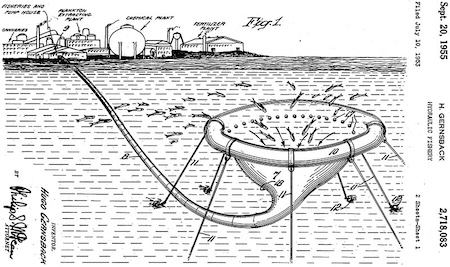Science Fiction
Dictionary
A B C D E F G H I J K L M N O P Q R S T U V W X Y Z
Self-Propelled Underwater Fish Cages

A self-propelled underwater fish cage developed and recently tested by an MIT researcher may provide a way for fish farming to move out onto the open ocean.
(Giant self-propelled fish farm video)
Cliff Goudey, director of MIT Sea Grant's Offshore Aquaculture Engineering Center, is exploring a different approach to moving the cages. By placing large, slow-turning propellers directly on a cage, Goudey frees it from the normal constraints of a boat. His system uses a pair of eight-foot diameter, electrically powered propellers, with 6.2-horsepower underwater motors. The motors are powered through tethers to the surface attached to a diesel generator and a pair of motor controllers mounted on a small boat.Recently he tested the approach at Snapperfarm Inc., an offshore fish farm in Culebra, Puerto Rico, that grows cobia in submerged cages. By fixing a pair of the propellers to the mid-depth of a 62-foot diameter AquapodŽ fish cage in a horizontal line 9 feet apart, Goudey maneuvered the cage as well as any boat-based system.
Mobile fish cages could solve a variety of problems related to fish farming in the open ocean. The limiting factor in the number of fish that can be raised in a cage is often the oxygen content of the water during slack water. A moving cage could ensure a steady supply of fresh water.
Fish farming, in the sense of raising fish in a land enclosure for food, has been around for centuries. Mariculture, the raising of fish for food in the open ocean, is only a few decades old.
Update 27-Jan-2024: This is a patent drawing submitted by Hugo Gernsback, not part of a science fiction story, however:

(Hydraulic Fishery patent drawing by Hugo Gernsback in 1953)
End update.
From MIT tests self-propelled cage for fish farming.
Scroll down for more stories in the same category. (Story submitted 9/11/2008)
Follow this kind of news @Technovelgy.| Email | RSS | Blog It | Stumble | del.icio.us | Digg | Reddit |
Would
you like to contribute a story tip?
It's easy:
Get the URL of the story, and the related sf author, and add
it here.
Comment/Join discussion ( 2 )
Related News Stories - (" Biology ")
Black Fungus Blocks Radiation
'You were surrounded by Astrophage most of the time' - Andy Weir, 2021.
Lunar Biorepository Proposed For Cryo-Preservation Of Earth Species
'...there was no one alive who had ever seen them. But they existed in the Life Bank.' - John Varley, 1977.
Let's Make Slaver Sunflowers! Engineering Plants To Reflect Light
'The mirror-blossom was a terrible weapon.' - Larry Niven, 1965.
Machete-Wielding Philodendron Isn't Going To Take It Anymore
'The tree ended its wild larruping, stood like a dreaming giant liable to wake into frenzy at any moment.' - Eric Frank Russell, 1943.
Technovelgy (that's tech-novel-gee!) is devoted to the creative science inventions and ideas of sf authors. Look for the Invention Category that interests you, the Glossary, the Invention Timeline, or see what's New.
Science Fiction
Timeline
1600-1899
1900-1939
1940's 1950's
1960's 1970's
1980's 1990's
2000's 2010's
Current News
iPhone Air Fulfils Jobs' Promise From 2007 - A Giant Screen!
'... oblongs were all over the floor and surfaces.'
ChatGPT Now Participates in Group Chats
'...the city was their laboratory in human psychology.'
iPhone Pocket All Sold Out!
'A long, strong, slender net...'
Did The Yautja Have These First?
What a marvel of ingenuity the little device was!
Jetson ONE Air Races Begin, Can Air Polo Be Far Behind?
'If you're one of those rarities who haven't attended a rocket-polo "carnage", let me tell you it's a colorful affair.'
Will Space Stations Have Large Interior Spaces Again?
'They filed clumsily into the battleroom, like children in a swimming pool for the first time, clinging to the handholds along the side.'
Mornine Sales Robot
'Robot-salesmen were everywhere, gesturing...'
Bipedal Robot Floats Gently While Walking
'a walking balloon proceeded with long strides of its aluminum legs...'
Musk Idea Of Cars Talking To Each Other Predicted 70 Years Ago
'My cars talk to one another.'
Elegant Bivouac Shelter Produces Water And Electricity
'There was nowhere on the planet where science and technology could not provide one with a comfortable home...'
X-Control Janus-1 A Suitcase Aircraft
'You will notice that it... fits the suitcase nicely.'
'AI Assistants' Are Actually Less Reliable For News
'Most men updated their PIP on New Year's Day...'
YES!! Remote Teleoperated Robots predicted by Technovelgy!
'...a misshapen, many-tentacled thing about twice the size of a man.'
Will Robots Ever Fold Landry?
Where have you gone, Mrs. Robinson?
Will AIs Give Better Results If You're Rude To Them?
'I said, "Listen up, motherf*cker.'
Cybertruck Robotic Arm F10 Drone Launch!
Drone away!
